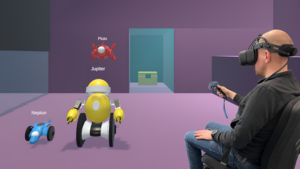Publikationen
Ausgewählte Publikationen
Hier finden Sie ausgewählte Publikationen aus den letzten Jahren. Eine ausführliche Liste der Publikationen finden Sie auf der Google Scholar oder DBLP Seite von Stefan Schneegaß.

Art der Publikation: Beitrag in Zeitschrift
Exploring a GPT-based large language model for variable autonomy in a VR-based human-robot teaming simulation
- Autor(en):
- Lakhnati, Younes; Pascher, Max; Gerken, Jens
- Herausgeber:
- Robotics, Frontiers In; Ai
- Titel der Zeitschrift:
- Frontiers in Robotics and AI
- Jahrgang (Veröffentlichung):
- 2024 (2024)
- Heftnummer:
- 11
- ISSN:
- 2296-9144
- Digital Object Identifier (DOI):
- doi:10.3389/frobt.2024.1347538
- Volltext:
- <a href="/fileadmin/fileupload/I-HCI/frobt-11-1347538-1.pdf" class="pdf">Exploring a GPT-based large language model for variable autonomy in a VR-based human-robot teaming simulation (23 MB)</a>
- Link zum Volltext:
- https://www.frontiersin.org/articles/10.3389/frobt.2024.1347538/full
- Zitation:
- Download BibTeX
Kurzfassung
In a rapidly evolving digital landscape autonomous tools and robots are becoming commonplace. Recognizing the significance of this development, this paper explores the integration of Large Language Models (LLMs) like Generative pre-trained transformer (GPT) into human-robot teaming environments to facilitate variable autonomy through the means of verbal human-robot communication. In this paper, we introduce a novel simulation framework for such a GPT-powered multi-robot testbed environment, based on a Unity Virtual Reality (VR) setting. This system allows users to interact with simulated robot agents through natural language, each powered by individual GPT cores. By means of OpenAI’s function calling, we bridge the gap between unstructured natural language input and structured robot actions. A user study with 12 participants explores the effectiveness of GPT-4 and, more importantly, user strategies when being given the opportunity to converse in natural language within a simulated multi-robot environment. Our findings suggest that users may have preconceived expectations on how to converse with robots and seldom try to explore the actual language and cognitive capabilities of their simulated robot collaborators. Still, those users who did explore were able to benefit from a much more natural flow of communication and human-like back-and-forth. We provide a set of lessons learned for future research and technical implementations of similar systems.
